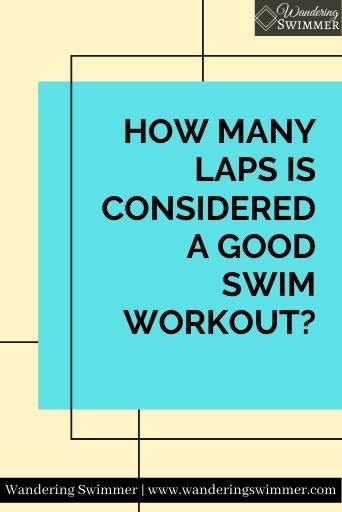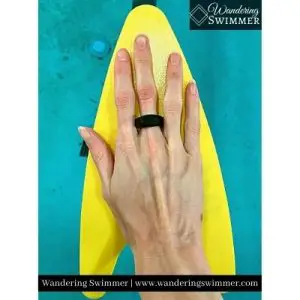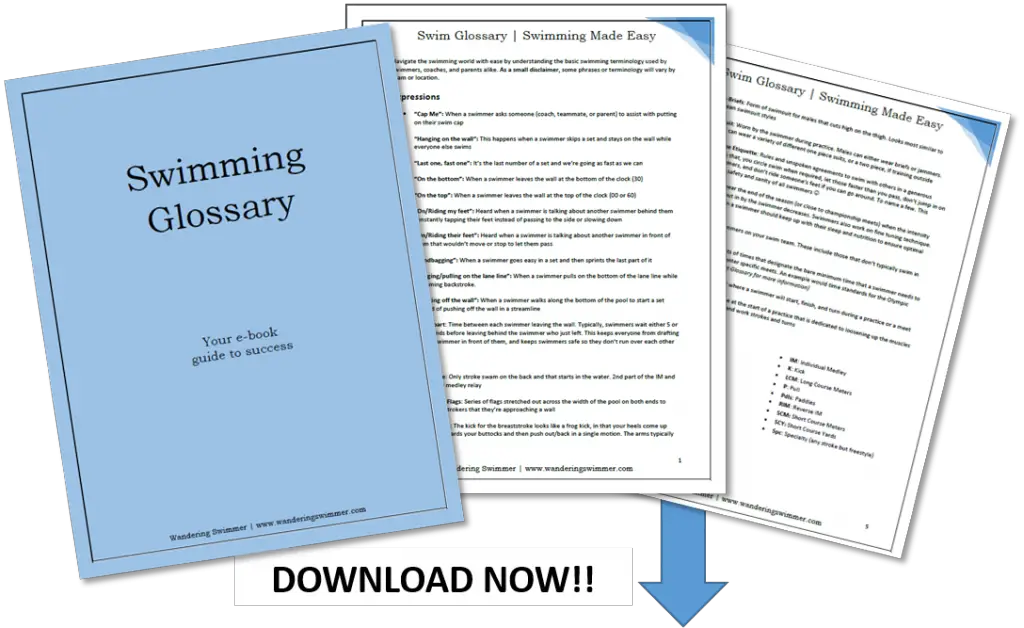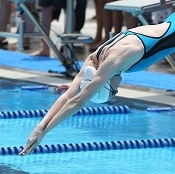When you first start swimming, it’s tempting to ask how many laps is a good swim workout? The good news is that you don’t have to swim hundreds of laps or train like an Olympic swimmer to have a good swim workout.
Related article: Swimming Basics to Get You Started
Disclosure: This post may contain affiliate links, meaning we earn a small commission at no cost to you if you purchase something through one of our links. As an Amazon Associate, we earn from qualifying purchases. Please check out our disclosure page for more information.

- How Many Laps is a Good Swim Workout?
- What is Considered a Good Swim Workout?
- Swim Workout Examples
- How Long Should I Swim for a Good Workout?
- How Many Laps Should I Swim to Lose Weight?
- 10 Tips to Have a Better Swim Workout
- 1. Set SMART goals for your swimming
- 2. Warm-up and cool down properly
- 3. Work in drill and technique sets
- 4. Add interval training to your workout
- 5. Use Swim Gear
- 6. Mix Up Your Strokes
- 7. Write Your Workouts Ahead of Time
- 8. Change up Your Swim Workouts
- 9. Join a team or find a fitness buddy
- 10. Swim Consistently
- In Closing
- Bonus Content
How Many Laps is a Good Swim Workout?
For a thirty-minute workout (in a 25 yard or meter pool), the following number of laps can be considered a good swim workout:
- Beginner: 20-30 laps (500-750 yards/meters)
- Intermediate: 35-50 laps (875 – 1250 yards/meters)
- Advanced: 60 laps (1500 yards/meters)
- Elite: 75 laps or more (1875 yards/meters)
While these numbers are by no means a hard and fast rule, they can help you set a goal based on your swim level. And something to build/work towards.
I will note that it’s not just about the number of laps that you swim. It also comes down to the quality and intensity of those laps.
I’ve found in my 20 years of competitive swimming that my coach could give us the most brutal 30 minute workout that would leave me feeling like death. But I only swam about 40 laps total. Alternatively, I could swim for the same half hour and put in more than 100 laps but leave the pool feeling like I accomplished nothing.
I tell new swimmers that a mile is a mile. But how you swim those laps in the mile makes the biggest difference.
Related articles:
My years swimming thousands of workouts has taught me that you’ll get a better workout if you increase the intensity/speed for some of the laps instead of swimming it straight through at a moderate pace.
That said, if you’re recovering from a surgery and using swimming laps as a means to recover, it is more important to focus on motion than intensity. You should also work with your doctor or trainer to develop a recovery plan that’s best for you.
What is Considered a Good Swim Workout?
So what makes a good swim workout?
In my humble opinion, a good swim workout should consist of a warm-up, the main set, some drills, and a cool down. At the minimum. I also like to include a kick set but that’s just personal preference 🙂
Swim Workout Examples
What everyone can swim differs on their swimming ability. Below, we’ve listed a few 30-minute swim workouts for you to try the next time you’re at the pool.
Please note that these are just suggestions. And you should modify them to suit your swimming, health, and fitness level.
Beginner:
- Warm Up: 200 swim
- 4x50s Kick/Technique, alternate kick, and technique by 50 (15 seconds rest)
- 4x75s swim (30-40 seconds rest)
- Cool Down: 150 easy swim
- Total Workout: 850 yards/meters (34 laps)
Beginner/Intermediate
- Warm Up: 200 Swim, 100 Kick, 100 Drill
- 6x25s: sprint halfway, easy the rest of the 25 on 45 seconds interval
- 4x150s choice, kick first 25, swim 100, kick last 25 (30-40 rest between each round)
- Cool Down: 200 easy swim
- Total Workout: 1350 yards/meters (54 laps)
Intermediate/Advanced
- Warm Up: 300 swim, 100 kick, 3x50s build each 50
- 5x50s (25 technique down, 25 swim back), IM order
- 4x200s
- 100 choice stroke on 1:30
- 2x25s sprint choice stroke w/ 10 rest
- 50 easy swim
- Cool Down: 200 easy swim
- Total Workout: 1800 yards/meters (72 laps)
How Long Should I Swim for a Good Workout?
Again, this varies based on where your swimming and fitness level is.
Ideally, you should plan for at least a 30-minute swim for a good swim workout if you’re a beginner. And by 30 minutes, I mean 30 minutes of actually swimming. Not resting on the wall for 5-10 minutes at a time during a 30-minute window 😉
Remember that it’s not just the number of laps that make your swim workout good. It’s also the quality and intensity.
That said, you also need to adjust for how long you can swim. Those that are more advanced should aim for an hour long workout to get the most out of the pool.
If you can’t swim longer than 15 minutes, then you shouldn’t push for 30 minutes right away. Instead, you’ll need to build up to that 30-minute goal. Try to add an extra minute a week. Or another lap or two.
More Content for You:
- 7 Reasons to Wear Goggles When You Swim
- Can You Swim with Bad Eyesight?
- How to Pick the Right Swim Goggles for You
The key is to build up slowly and in a way that’s healthy for you. Once you reach a time or set number of laps that’s a good swim workout for you, then you can start working on increasing the intensity.
Finally, if you can, look at swimming at least 2-3 times a week. The more frequently you can hit the pool, the easier the laps become and the more you can improve 🙂
How Many Laps Should I Swim to Lose Weight?
If you’re wanting to burn some calories, swimming is a great way to do so. Typically, you can burn more calories by swimming than running. Which is great news for those that don’t like to run (myself included!)
How many calories you burn while swimming does vary by a few factors, such as the stroke you’re swimming, the speed/intensity that you swim at, and your weight.
Because of these factors, it’s hard to say what that magical number is to lose weight while swimming.
However, if you aim for at least 30 minutes of swimming a day, a few times a week, you can set yourself up for a good start.
More Content for You:
- 6 Reasons Why You Should Wear a Swim Cap
- Why Does My Swim Cap Slide Off?
- The 7 Best Swim Caps for Long Hair
If you can, mix up the strokes that you’re swimming. This will ensure you’re working each stroke and taking advantage of burning the most calories that you can.
Nutristrategy has a good breakdown of the number of calories burned in an hour per stroke.
We do recommend connecting with your doctor or trainer/coach if you plan to swim to lose weight. They can suggest the best workouts and nutrition plans for you, as exercise is only part of losing weight. Eating right also goes a long way.
10 Tips to Have a Better Swim Workout
Want to have a better swim workout? Here are some tips for those just starting that can help you feel accomplished after your next swim.
1. Set SMART goals for your swimming
Before you start swimming, it helps if you have a goal in mind. Preferably, one that you can achieve. This will help increase and hold your motivation throughout your swim as you work towards your overall goal.
These can be as simple as swimming more laps in an hour. Or decreasing the time it takes to swim a mile.
Whatever your goal, make sure it’s realistic. Otherwise, you can end up feeling discouraged if you make little to no progress on it.
2. Warm-up and cool down properly
Before and after every swim, you should take the time to warm up and cool down. Based on how many laps you plan to swim during your workout, this can be as few as 6 or as much as 40.
Related article: Basic Swimming Terminology
Doing this can help prevent injury, as it warms up your muscles before you start moving on to harder sets. And you allow your muscles to flush out any lactate following your workout to reduce cramps and soreness.
You should also stretch before you get into the water. Stretching allows your muscles to warm up before you even start swimming and can also help prevent injury.
3. Work in drill and technique sets
Going fast is always fun.
But take the time to slow down for parts of your workout to focus on your technique. You can do this directly after a set or in between sets, as it’ll help you refocus your stroke. If you can, try to work technique for all four strokes.
Good technique allows you to swim easier and faster, and go further with each stroke you take.
And correct swim technique also reduces injury, as you’re not putting as much strain on your muscles.
4. Add interval training to your workout
To increase the intensity of your workout, add some interval sets to your next swim.
What are intervals? Intervals are where you set a time and distance for yourself and repeat for as many times as you want.
An example would be swimming a 50 freestyle in a minute. If it takes you 45 seconds to swim that distance, then you get 15 seconds rest before you go again. Repeat a few more times. And follow up with an easy swim once you’re done.
More Content for You: Swimming on Your Period (And Why You Should)
If you don’t feel ready to start using interval sets to your workout, try watching the clock instead. Use it to keep your rest consistent and ensure you’re not resting too long.
5. Use Swim Gear
Swim gear is my favorite way to add to my swim works. They not just add intensity to my workouts but they’re also great aids for improving swim technique.
For those just starting, you won’t need more than a kickboard and a pull buoy. And maybe some swim fins if you want to develop your kick more. These devices allow you to target specific portions of your stroke and build up your strength.
As the name would imply, a kickboard is to focus on your kick and build up your legs. Just as a pull buoy is used to work the pull of your stroke.
Swim fins can be used for kick and swimming sets. I recommend fins that have shorter blades, (such as Arena Powerfin Pro or FINIS Zoomers) as they’ll help you develop a faster kick
My favorite swim gear is swim paddles and I use at least 2-3 different kinds throughout my workouts. The below image is of the FINIS Freestyler Paddle, which, as the name implies, works your freestyle stroke.
You can read my review on it at A Swimmer’s Review of FINIS Freestyler Paddles and see if it’s something you’d be interested in using at your next workout!

Related articles:
6. Mix Up Your Strokes
Not all swim strokes are made equally. When it comes to difficulty, most competitive swimmers will tell you that the butterfly is the hardest stroke. It also burns the most calories out of the four strokes!
Because each stroke has its own level of difficulty and works the muscles in different ways, you can have a better swim workout if you mix up your strokes. This ensures you are working on different aspects of your stroke and varying the intensity of your workout.
Not everyone can swim the four strokes (freestyle, backstroke, breaststroke, and butterfly), and that’s okay!
Swim what you can and try to work on other strokes if you can’t. Just don’t hurt yourself trying to do this.
7. Write Your Workouts Ahead of Time
One of the keys to having a good swim workout is to know your workout ahead of time.
Trying to make things up as you go along doesn’t allow for a good workout. Because you end up focusing on what you should do next instead of focusing on your swimming.
More Content for You: 4 Ways to Prevent Swimmer’s Ear
Instead, write out the workout that you want to do before you get to the pool. Or at best, have an idea of what you want to work.
This also gives you a goal for that workout and what you want to accomplish.
Keep your workouts in a plastic baggie to keep them dry. Or stick them on the edge of the pool for easier reading. Just remember to pick them up when you’re done! 😉
8. Change up Your Swim Workouts
It’s easy to get into the habit of jumping into the pool, swimming the same number of laps that you usually do, and then going home.
And we get it. You don’t have to worry about writing a new workout and it’s familiar.
However, it’s also the easiest way to start getting bored and skipping workouts. It can also lead to your body burning out and no longer seeing results
Instead, do something different every time you swim.
Can you do the same number of laps? Of course! But instead of swimming it straight through, add in a few laps of kick. Or switch up how you swim those laps. Swim 3 laps freestyle and your 4th lap a different stroke.
Part of the fun of swimming is doing what you like best and tapping into your creativity!
9. Join a team or find a fitness buddy
To help have a good swim workout or to improve your next swim, look for a swim buddy. Or join a swim team. Having someone there to help motivate you can decrease the chances of you skipping a workout.
Related article: 14 Reasons to Join Masters Swimming
They can also help hold you accountable to whatever goals you set. Especially if you’re working towards the same goal.
Commit to helping each other out. And make sure that you actually work out. Not sit around and talk 😉 That part can always come after!
10. Swim Consistently
Try to stay consistent with your swimming workouts. The more you stay consistent with a schedule and the distance you swim, the easier things become. And the less likely you are to want to stop.
Swimming consistently can make it easier to start to increase certain aspects of your workout. Look at increasing the frequency that you swim per week, or the number of laps you swim each day.
At the start, it can be challenging. But stick with it and you’ll find yourself improving your swim workouts!
In Closing
Trying to determine how many laps is a good swim workout shouldn’t be the sole focus of your next workout. Instead, combine the distance swam with the intensity of your workout for the best results. In doing so, you should see some improved results in your swimming!
As always, happy swimming.
– Chevron
Bonus Content
How to Make Your Swimsuit Last Longer: Swimsuits can be expensive. Whether you’re using them for training, working out, or lounging by the pool, how can you make your swimsuit last longer?
Do’s and Don’ts of Swim Etiquette: If you’re new to swimming, you may have heard a reference to ‘proper swim etiquette’. But no one will tell you what exactly it is. So what is swim etiquette and what are the do’s and don’ts of it?

Want to Improve at the Pool?
Join swimmers and swim parents to receive my free newsletter and receive a free Swimming Glossary e-book as a thanks!
Every month you’ll receive tips and coaching to help you find success at the pool.
About

Chevron is a current competitive swimmer with almost 20 years of experience at the local, national and international level. A current USA Swimming and US Masters Swimming athlete, she’s committed to providing guidance to all levels of swimmers and believes that everyone should know how to swim.